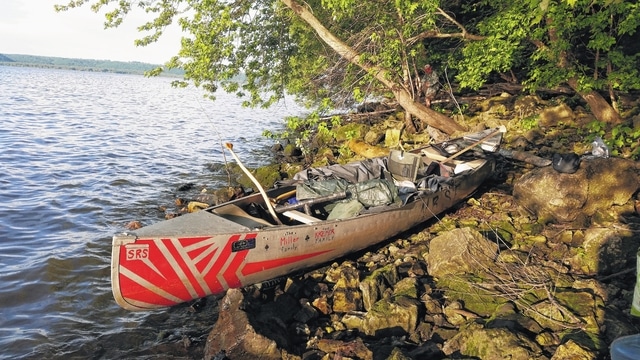
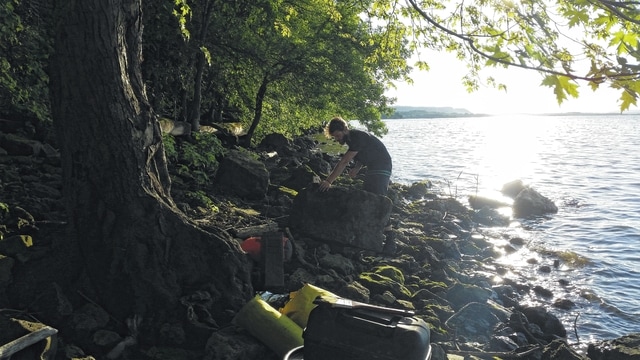
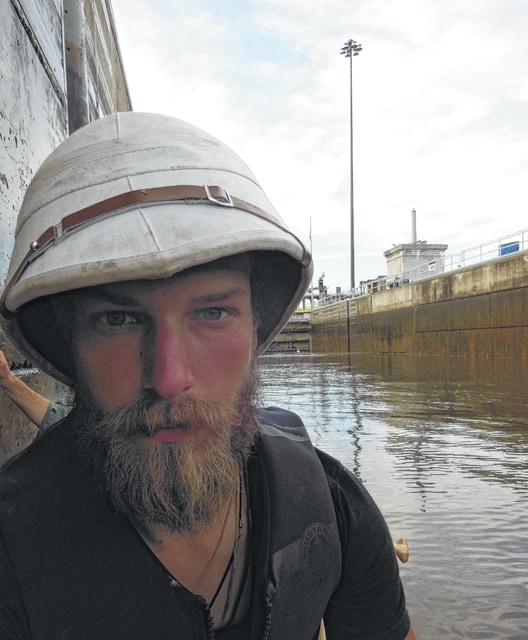
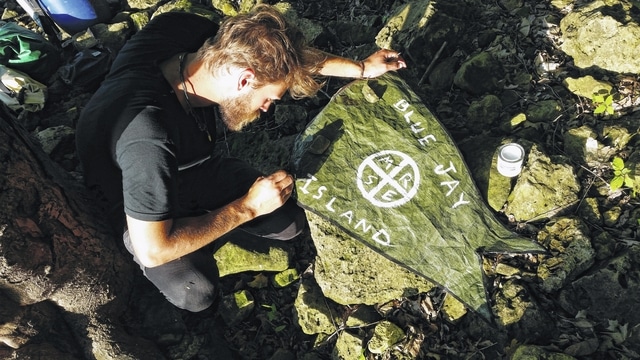
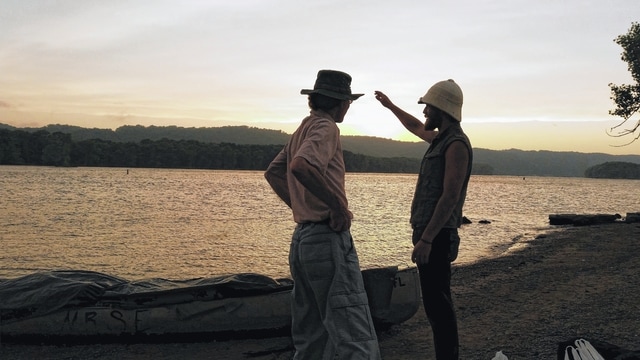
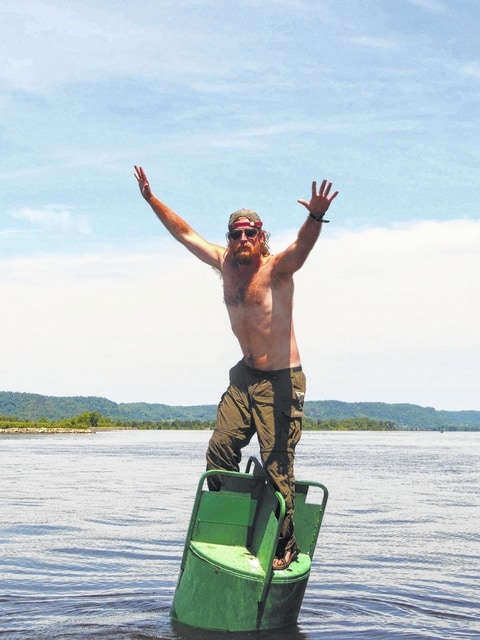
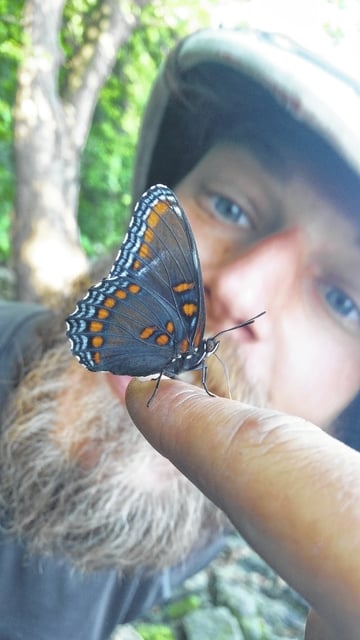
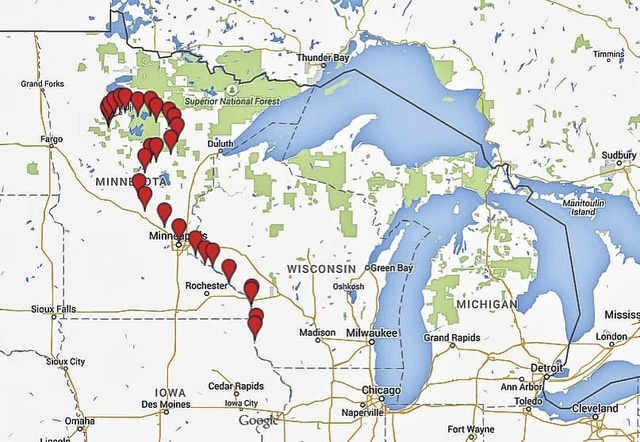
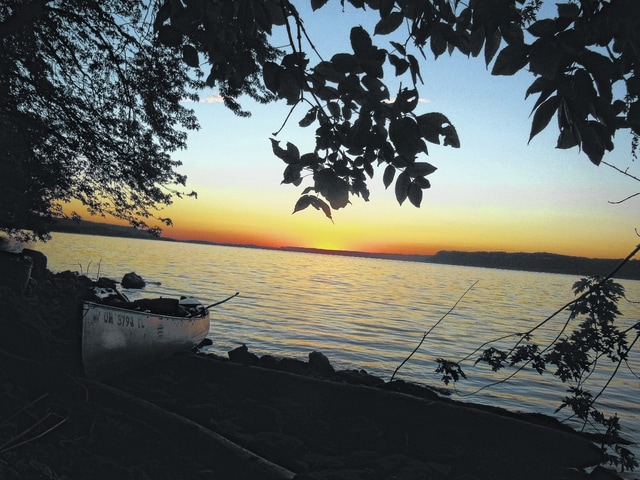
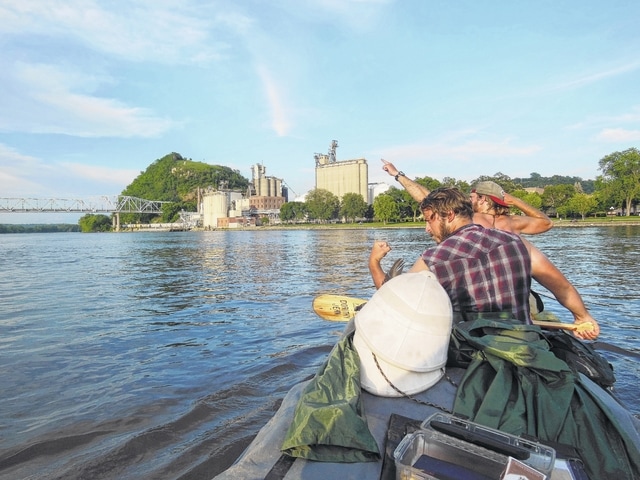
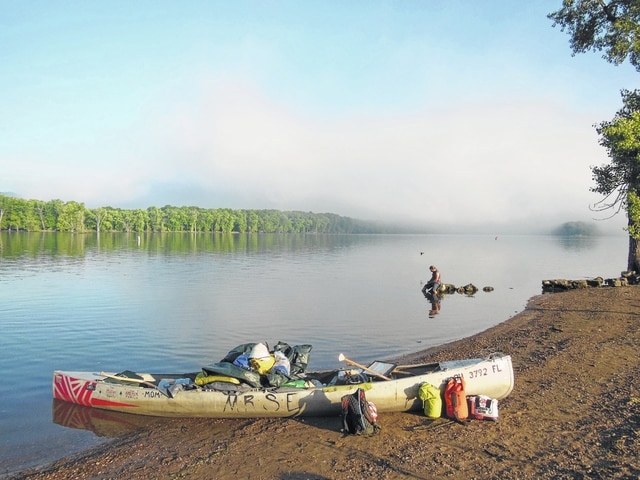
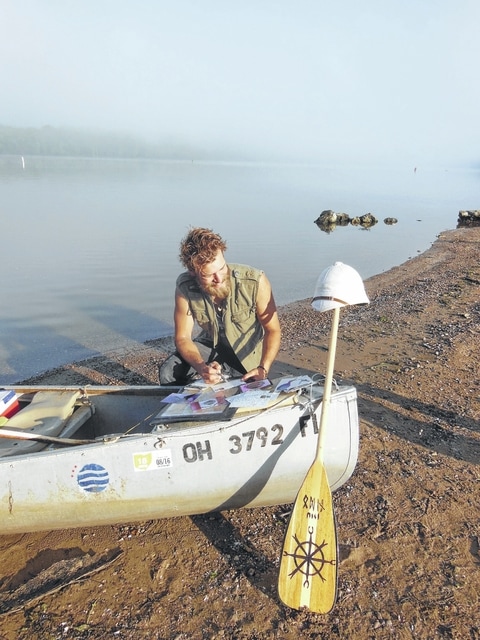












PRAIRIE DU CHIEN, Wis. — The long and winding Mississippi River has proven to be just that as the members of the Mississippi River Survey Expedition have traveled back and forth between Wisconsin and Iowa during their travels this week.
“We’re in the southern point of Wisconsin,” said Forrest Schoessow, 25, of Sidney. “We’ll be leaving Wisconsin the next day or so. We’ve been bouncing back and forth between Iowa and Wisconsin.”
Schoessow, along with his fellow travelers, Shea Selsor, 25, of Piqua, and Alex Ross, 26, of Sidney, have traveled a total of 747 miles on the Mississippi River since their journey began on May 20. The total length of the trip is 2,340 miles.
“It’s been a great week,” said Selsor. “We’ve traveled a lot of miles. The storms have slowed us down and we’ve encountered the locks on a frequent basis.”
The trio saw scattered thunderstorms during their travels last week.
“It’s been interesting with the lightening,” said Schoessow. “It’s alarming to see the lightning across the sky. ”
When lightening is spotted, the three paddle to shore where they find shelter from the weather.
“We are beginning to get used to protecting ourselves and our canoe from thunderstorms. In a storm, our canoe is like a giant lightning rod floating out in the middle of the water,” said Schoessow. “We aren’t taking any chances, and have to get to shore so that we can batten down our storm guard and reef our tarpaulin.”
Ross said the lightning storms are a real concern to them, but it also provides a time to rest while the storm approaches them.
“The breaks are sometimes nice,” said Ross. “I can get some drawings done then. At night, with all our duties, cooking and preparing the fire and then preparing for the morning, there hasn’t been a lot of time for me to draw.”
Ross is continuing to make sketches of the people they meet.
“I want to do more of Shea and Forrest,” he said. “I’d like to be really good at drawing them by the end of the trip.”
A storm on Saturday found them seeking shelter on Prairie du Chien, Wisconsin.
“We took shelter from a storm on an island and stumbled upon the largest buckskinner and fur-trade historical reenactment in the Midwest!,” said Schoessow. “We spoke to many people who traveled around to history festivals and had attended the Piqua Heritage Festival at Johnston Farm. It was with a heavy heart that I told them that the Heritage Festival hasn’t been held recently due to lack of public interest and funds. I grew up attending the festival and learned a great deal about the Miami Valley’s rich settler and Native American history at the Johnston Farm grounds.”
There were historical tents set up around the island. They watched people prepare pelts the old-fashioned way.
“We were lucky we had a day to use at the festival,” said Ross. “The festival was fantastic. It’s so wonderful and important that people take pride in their history.”
Schoessow said it’s important for everyone to be proud of their heritage and to know as much about it as possible.
While on the island of Prairie du Chien, “Mark,” a resident took the trio to Walmart so they could restock for the week.
“There’s an island bridge to downtown,” said Ross. “Years ago they were in a flood situation, so they moved the town from the island to where it is now in downtown.”
Schoessow said they were hoping the storms would cause the river to flow faster.
“The Army Corps of Engineers maintain the water level with the locks,” said Schoessow. “So that causes a constant speed for the water to flow.”
Of the 28 locks on the Mississippi River, they have paddled through 11 of them — eight during the past week.
“We are traveling at about 5.6 miles per hour on average. However, when we really need to get somewhere quickly, we can clock 8 miles per hour for short periods of time,” said Schoessow. “The current speeds fluctuate greatly. At times, the river’s speed has carried us along at nearly 4 mph, but most of the time the current stays around 2 mph. Every time we encounter a lock and dam, the current speed drops down to a snail’s pace (0.2 mph) which makes the going very slow.”
The barges, said Selsor, have the right-of-way in the locks.
“Sometimes we’d have a two hour wait,” said Selsor. “That delayed us a bit, but I’m happy about our mileage for the week.”
Ross said once they get through all the locks, their travel time should increase. The last lock they encounter will be in St. Louis.
“I think we’ll have a good week coming up,” said Ross. “We’ll be getting on faster water and with more time on the river, there won’t be as much anxiety and pressure on us.”
Selsor said they sailed across Lake Pepin, which is a lake within the river. It was 20 miles long.
“It was a giant lake with communities on it,” said Selsor. “There were river towns after river towns. We’re seeing a lot more fishermen and more paddlers. They take pride in the river and they respect the river.
“When we say where we’re going, they are impressed with us that we’re going all the way on the river.”
Selsor said they met another gentleman who is also traveling the length of the Mississippi River.
“We’ll soon be catching up with an 80-year-old man who is padding the river,” said Selsor. “He has a film crew with him and we should be catching up with him this week. He started at the same place in Minnesota that we did. We’re excited about meeting him.”
Selsor said they have also seen other people in pleasure boats who have asked them if they’d like a tow.
“We declined their offers,” said Selsor. “I’m pretty proud of that.”
Selsor said he has felt muscles that he hasn’t felt in a while. The endurance athleticism required for the trip is something new to him.
“We’re doing the same thing for 12 hours a day,” said Selsor. “We are all paddling together. There’s a lot that goes through your mind and we all have to be on the same page. I’ve been sore in the morning. At night when we camp, we try to get as much sleep as we can so we can do it all over again.”
“We’re still seeing water fowl,” said Schoessow. “We watched bald eagles catching fish and them fighting over them. There’s not so many critters now. I think we’re out of beaver and river otter territory.”
They have seen some new species of birds as they travel down the river.
“We’ve seen bird changes,” said Schoessow. “We’re seeing summer birds and not migratory birds.”
Schoessow said they are adding a new critter to the postcards they are sending to their supporters. The Iowa Pleistocene Snail, which was frozen during the ice age and then survived when the ice melted, was found in caves in Iowa. The snail is on the endangered list of species in danger of becoming extinct.
“This unique little snail, is an ancient creature that has survived from the last Ice Age. It was thought to be extinct and only found in fossils, but was recently rediscovered by biologists working in the Driftless Area (where we are right now) between Wisconsin, Iowa, and Illinois. By studying these endangered snails, we can learn a great deal about America’s ancient plants and animals,” said Schoessow.
In Wisconsin, their mascot was the long-eared bat.
“Bats play a very important role for our nation’s ecology and economy, they work to balance out the insect populations. Without bats, insect populations can sky-rocket very quickly, which can result in great losses for America’s crop farmers and timber-workers,” said Schoessow. “The only substitute for bats is greater reliance upon pesticides, which will only create more problems in the long run. Populations of the long-eared bat have dropped dramatically in the Midwest primarily to white-nose syndrome, a disease that has killed millions of cave-hibernating bats of different types throughout the United States and Canada. Bats need our help and support!”
The week has been long and hard, all three agree. They are spending 12 hours a day paddling down the river.
“We’re beginning to realize how difficult the trip is,” said Schoessow. “The physical aspect is tough. We mentally have to be prepared for each day before we get in the canoe.
“At the beginning of every day, we are reluctant to get into the boat at this point. We have paddled over 747 miles now and that means a lot of hard work sitting down. My hands feel like leather gloves and sitting for so long is becoming painful,” said Schoessow. “However, we all feel very comfortable in our positions aboard the Calypso now. At the end of the day, we are always proud of how far we have come along. We may be slightly disappointed in ourselves some days for not accomplishing our mileage goals, but regardless, at the end of the day we are exhausted and grateful for food and rest. We know that we have worked hard.”
Each of them is concentrating on reaching their goal — the Gulf of Mexico.
“We’ve had to wait at the lock and dams,” said Schoessow. “The barges go through and we saw a Navy SEAL team go through. We’ve had to wait two hours for the barges to get through the locks.
“Endurance and fortitude (both mental and physical) are becoming very important on this journey,” said Schoessow. “The physical aspect of our mission is challenging. We set goals for ourselves — for the week, for the day, for the hour. I will make it to that rock. I will make it to that tree. We will reach the lock and dam by sundown! We traveled through a lock at night this week. It was very interesting. They spotted us approaching the dam with a searchlight and directed us in. It was very surreal. We felt like we were going through giant gates from Star Wars or something like that.”
During their week of travel, the trio began preparing projects on behalf of their supporters of the trip.
“We have been working hard during our free-time on projects for supporters. We have been painting and illustrating our own postcards, and have been coming up with a unique haiku poem to print on each card. We have also been preparing flags representing some of the families and individuals who have supported us,” said Schoessow. “We will be charging out of the canoe onto islands and sandbars and conquering them on behalf of our supporters. So long as the native wildlife remains peaceful during our invasion, it should be a great deal of fun. We will plant a flag on behalf of our supporters and prepare a map of the area for them. We also will be planting trees on behalf of some of our supporters.”
They’ve seen the pristine waters of the Mississippi to water polluted by plants along its banks. Now they are beginning to see another type of pollution — trash and rubbish.
“We’ve seen trash and rubbish in the water,” said Schoessow. “It’s mixed in with the driftwood. We’re cleaning up the shores whenever we can.”
The travelers are going by the saying ‘leave no trace’ and that’s what they’re trying to do.
“I hope people will consider recycling more,” said Schoessow. “It helps make Earth a better place for future generations. The river has a mission of getting to the ocean. If there’s trash in it, the trash goes along with it.”
Ross agrees recycling is important.
“People here take the environment seriously,” said Ross. “People need to support recycling and reduce using materials (plastic bottles, etc.) if you can.”
While they camp overnight, Ross has been reading “Life on the Mississippi” by Mark Twain.
“The river was very different then,” said Ross. “It would jump and shorten itself. That confused the countryside around it. His time was very different but there are a lot of similarities.
The Mississippi River, he said, is different that other rivers as it narrows and gets deeper the longer you travel it. Other rivers become wider, said Ross.
And if the trio can share one thing with all the readers of their adventure, it would be for each person to get outside this summer and enjoy nature.
“It’s a great summer to go out and build a fort,” said Schoessow. “Or build a tree house. Go explore the waters of Tawawa Park or Lake Loramie.”
“I wish I had spent more time outside as a kid,” said Ross. “go build that tree house or make up a game. Look at the stuff around you. Observation is a wonderful thing.”
“I encourage everyone in the Miami Valley to go paddling and fishing and to use the river,” said Selsor. “That’s the only way to keep the river safe.”
On a final note for the week, Selsor took time to “Thank all of our fathers for being amazing men. Without them this trip wouldn’t have happened. Happy Father’s Day to all the fathers out there.”
The trip can be followed on their website, http://mrexpedition.squarespace.com and on Facebook, https://www.facebook.com/m.r.s.expedition. The Sidney Daily News has also linked up with the expedition’s Facebook account on its site, https://www.facebook.com/SidneyDailyNews.

